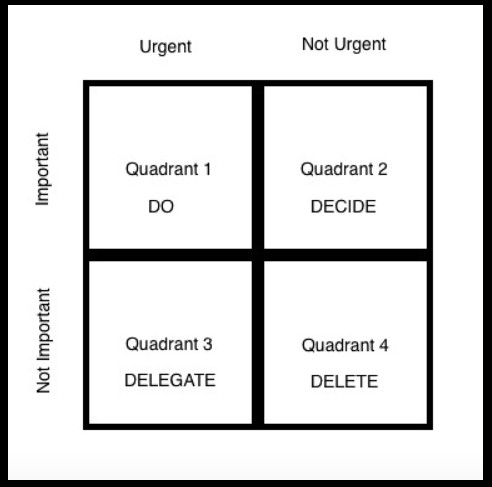Managing time effectively can feel like an endless battle against overflowing to-do lists and constant distractions. The key isn’t about working harder but making smarter decisions on what truly deserves your attention. That’s where the Eisenhower Matrix steps in—a simple yet powerful tool for prioritizing tasks with clarity.
In this article, you’ll learn how the Eisenhower Matrix works, why it’s more effective than traditional task lists, and how to apply it in your daily routine.
What is the Eisenhower Matrix?
The Eisenhower Matrix, also known as the Urgent-Important Matrix, is a time management tool designed to help you prioritize tasks based on two key criteria: urgency and importance.
Named after Dwight D. Eisenhower, the 34th President of the United States, who famously distinguished between tasks that are “urgent” and those that are “important,” this matrix provides a structured approach to decision-making.
It’s divided into four quadrants: Do First (urgent and important), Schedule (important but not urgent), Delegate (urgent but not important), and Eliminate (neither urgent nor important). This layout helps you quickly assess where each task fits, ensuring that your time and energy are spent on what truly drives results.
The power of the Eisenhower Matrix lies in its ability to shift your focus from reactive task management to proactive decision-making. Instead of getting caught up in the cycle of handling only urgent issues—which often leads to burnout—you’re encouraged to invest more time in tasks that are important but not urgent.
These are the activities that contribute to long-term goals, strategic planning, and personal growth. By consciously scheduling these tasks, you reduce the likelihood of them becoming last-minute emergencies, ultimately improving productivity and reducing stress.
How to Use the Eisenhower Matrix for Productivity
1. Identify and List Your Tasks
Start by writing down every task you need to tackle, big or small. Don’t overthink it—just brain-dump everything swirling in your head onto paper or a digital note. The goal is to get a clear, unfiltered view of what’s demanding your attention.
Once your list is complete, resist the urge to panic. Having a long list isn’t the problem; it’s not knowing how to handle it that causes stress. This is where the Eisenhower Matrix starts to work its magic.
2. Determine Urgency and Importance
Look at each task and ask: “Is this urgent? Is it important?” Urgent tasks require immediate action, while important tasks contribute to long-term goals or values. Not everything that screams for attention is actually important—don’t fall for that trap.
Be brutally honest during this step. Just because something feels pressing doesn’t mean it’s a priority. This mindset shift is what separates busy people from productive ones.
3. Place Tasks into the Four Quadrants
Now, sort your tasks into four categories: Do First (urgent & important), Schedule (important but not urgent), Delegate (urgent but not important), and Eliminate (neither). This framework helps you see where your energy should go instead of reacting to everything at once.
Think of it as organizing your mental closet. Some tasks are the everyday essentials, some need to be neatly folded for later, some can be handed off, and others? They’re just clutter—toss them.
4. Take Action Based on Each Quadrant
For tasks in the Do First quadrant, tackle them immediately—these are your high-impact, time-sensitive priorities. Tasks in the Schedule quadrant should be added to your calendar with clear deadlines, so they don’t sneak up on you.
When it comes to the Delegate quadrant, find someone else who can handle these efficiently—it’s not about being lazy, it’s about working smarter. Lastly, for the Eliminate quadrant, let go of tasks that add zero value. Trust me, your productivity will thank you.
5. Review and Adjust Regularly
The Eisenhower Matrix isn’t a one-and-done deal. Set aside time each week to review your matrix, adjust priorities, and shift tasks between quadrants as needed. Life changes fast, and your priorities should adapt just as quickly.
This regular check-in keeps you proactive rather than reactive. It’s like having a productivity compass, always pointing you toward what truly matters, even when things get chaotic.
The Four Quadrants of the Eisenhower Matrix
The Eisenhower Matrix is divided into four quadrants that help you prioritize tasks based on urgency and importance. Each quadrant has a specific purpose, guiding you on what to do immediately, what to schedule, what to delegate, and what to eliminate.
This simple structure helps you focus on what truly matters without getting overwhelmed by the noise of daily tasks.

| Quadrant | Description |
| Quadrant 1: Urgent & Important (Do First) | Tasks that demand immediate attention with serious consequences if ignored, like deadlines, crises, or urgent problems. Handle them quickly to prevent burnout. |
| Quadrant 2: Not Urgent but Important (Schedule) | Tasks key to long-term success, such as personal growth, planning, or relationship-building. They’re easy to overlook but crucial for future progress. |
| Quadrant 3: Urgent but Not Important (Delegate) | Tasks that feel urgent due to external pressure, like unnecessary meetings or minor requests, but don’t require your direct attention. Delegate when possible to protect your focus. |
| Quadrant 4: Not Urgent & Not Important (Eliminate) | Time-wasting activities with no real value, like mindless scrolling or busywork. Not about cutting all downtime but being mindful of unproductive habits. |
Eisenhower Matrix Example
Here’s a practical example of how the Eisenhower Matrix can be applied to a typical workday. This table helps visualize how tasks are categorized based on urgency and importance, giving you a solid foundation to create your own.
| Quadrant | Task Example |
| Urgent & Important (Do First) | Complete client project due today |
| Respond to an urgent email from your boss | |
| Not Urgent but Important (Schedule) | Plan next month’s marketing strategy |
| Exercise for 30 minutes | |
| Urgent but Not Important (Delegate) | Book travel arrangements for an upcoming trip |
| Answer routine customer service inquiries | |
| Not Urgent & Not Important (Eliminate) | Scroll through social media aimlessly |
| Attend an unnecessary meeting without a clear agenda |
5 Essential Tips for Prioritizing Your Tasks
1. Focus on What Moves the Needle
Not all tasks are created equal—prioritize the ones that make a real impact. Identify activities that directly contribute to your goals, not just tasks that keep you busy. Busy work feels productive, but it rarely drives meaningful results. Shift your focus to tasks that create progress, not just motion.
2. Apply the 80/20 Rule
The Pareto Principle suggests 80% of results come from 20% of efforts. Find that critical 20% and give it your full attention because that’s where real growth happens. Wasting energy on low-impact tasks drains your productivity without moving you forward. It’s not about doing more; it’s about doing what matters most, consistently.
3. Set Clear Deadlines
Deadlines create urgency and help prevent procrastination from creeping in. Even self-imposed deadlines can push you to act with purpose and discipline. Without them, tasks tend to linger, causing unnecessary stress and wasted time. Deadlines turn vague intentions into concrete commitments, making progress inevitable.
4. Learn to Say No
Protect your time by declining tasks that don’t align with your priorities. Saying no isn’t selfish; it’s a necessary boundary that keeps you focused. Every “yes” to something unimportant is a “no” to something that truly matters. The more comfortable you get with saying no, the more productive and intentional your time becomes.
5. Tackle High-Energy Tasks First
Handle complex or demanding tasks when your energy levels are at their peak. This prevents decision fatigue and keeps you sharp for the work that requires deep focus. Low-energy periods are perfect for simpler, less demanding tasks. Matching your energy to your workload helps you maintain consistent productivity without burnout.
Conclusion
The Eisenhower Matrix helps you prioritize tasks with clarity, focusing on what truly matters. It’s not about doing more but making smarter choices with your time. By sorting tasks into clear categories, you can reduce stress and boost productivity. Use it consistently, and you’ll feel more in control of your day.

We empower people to succeed through information and essential services. Do you need help with something? Contact Us.
Want a heads-up once a week whenever a new article drops?







